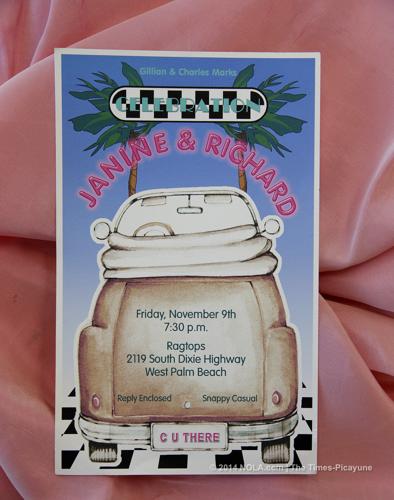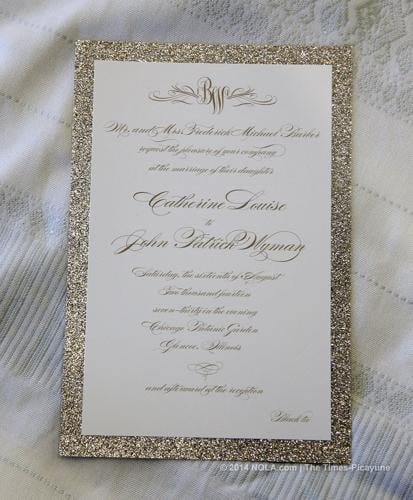One of the thrills in this age of Evite, email, text and Facebook invitations is receiving a printed invitation in the mail. The calligraphy on the front, the elegant or creative design, and, no doubt, the special feeling one gets of being invited to a swanky affair - one worthy of a printed invitation. (And, in my job as Social Scene editor, I admire the efforts of party organizers and am thrilled when they invite me cover their events!)
There remains, however, one perplexing line item on many invitations: What to wear, a.k.a., the dress code. I have seen them all - I think. "Cowboy Casual," "Black-Tie Fun," "Creative Casual" and "Swanky Chic" are a few that come to mind. A former co-worker would call them clever, but he wasn't being particularly complimentary.
Harsh? Maybe. But hear me out. While party hosts are crystal clear about the purpose, date, time and location of the event, it seems they enjoy getting creative when it comes providing with cues about what to wear. Really, what does Creative Casual truly mean? And does it mean the same thing to everyone?
Hosts with the most
I don't consider myself an etiquette expert, so I turned to those who make it their job to know: the Emily Post Institute. (And for those who may be unclear of who Emily Post is, she wrote the definitive book, "Etiquette," in 1922. The institute updates it, as well as publishes other books of etiquette.)
So, I spoke with Daniel Post Senning, great-great grandson of Emily Post and a co-author of Emily Post's "Etiquette, 18th Edition" and "Emily Post's Etiquette Advantage in Business, 3rd edition." He also is the author of "Emily Post's Manners in a Digital World, Living Well Online."
When I asked him about the evolution of invitation dress codes, he said, traditions regarding etiquette, such as table manners, often "evolve slowly" in society.
"If you look at Emily Post's original book, table manners seem very similar. Then there are those that evolve more rapidly, such as communication," Senning said. "Attire fits in the middle of this."
But what about the new dress code terms? "If you use a creative description, such as emphasizing a theme, be prepared to handle more phone calls about attire," Senning said. "You, as the host, need to get the word out, and provide a good (method) of contact for (guests with) any questions.
"It is your job as a host to make your guests feel secure," he said. "Good information about dress allows for your guests to be a good guest."
What Senning, Betty Hunley of Betty Hunley Designs, as well as Margaret Jones of Scriptura, all agree upon is this: If you are not clear about dress code, you better be prepared to handle a lot of phone calls about it.
"Whenever possible I counsel clients to leave off cheeky or potentially misleading attire wording," Jones said.
"When including attire on an invitation, it is best to be clear and straightforward. Humorous or colorful adjectives paired with attire can be confusing or too obtuse to understand," Jones said. "Direct and unambiguous wording makes guests feel most comfortable, for example coat and tie, jackets preferred, seersucker and sundresses."
So what to do when dress codes leave you wondering?
Here is a list of common and creative dress codes that I have come across (and I know I have probably just scratched the surface), with definitions created from my own experience as well as from advice offered by Hunley, Jones, Senning and other sources.
See if you agree.
Black tie:
For men, it's a tuxedo. For women, this can be a little trickier. If the party starts at 6 p.m. (with a cocktail hour), a woman can wear a more formal cocktail dress. If after 8 p.m., a long dress is preferred.
Black Tie Optional/Black Tie Preferred/Black Tie Invited/Formal attire:
While some may disagree, these all essentially mean the same thing. This is a formal, festive event.
"Black-tie optional says you are shooting for formality, but not as strict," Post's Senning said. "This also allows a man to wear a dark suit if he doesn't have a tuxedo." (And again, harkening to New Orleans in the summer, the white linen suit.)
This also allows women to wear a formal cocktail dress, but if the urge to wear a long gown arises, then do so.
Hunley likes "Black tie preferred" better than "Black tie optional": "Somehow 'preferred' seems a little clearer how the host would really like all the guests to dress."
The invitation sets the tone. Some events, such as New Orleans Museum of Art's "Odyssey Ball," may start earlier than 8 p.m., but organizers encourage long gowns, so this invitation suggests "formal attire."
In New Orleans, the summer often dictates another sort of formal attire: the white linen suit for men, which often takes the place of a tuxedo. Or, a white dinner jacket -- which tradition also dictates can only be worn between Memorial Day and Labor Day.
Of note, I also have seen black-tie invitations on which the evening attire is quite clearly spelled out ("Long dresses - no pants") which may seem to be extreme, but definitely gets the point across.
Costume de rigueur for Carnival balls
This is a French term that essentially means a strict dress code must be adhered to. It is usually seen on invitations for Carnival balls.
When I asked a few of my non-Carnival ball associates what they thought it meant, they all answered, "We get to wear a costume?"
No. (But a perfectly reasonable assumption.)
White tie and tails for men, and gloves if they are presenting a debutante; floor-length, evening gown for women and white, kid-leather gloves (length depending on sleeve length of dress.) And, no white dresses -- that's what the debutantes wear!
This is where one sees the clever creativity come into play. Some good, some ... too clever. Here are our best guesses at definitions.
Artsy casual:
Does this mean wear a paint-splattered shirt? Wild jewelry? All black? My interpretation is not cocktail attire, but more casual, with an element that makes it stand out, such as the aforementioned wild jewelry. Or maybe I have it all wrong.
Cocktail Chic:
Isn't cocktail attire already chic? But, OK, I'll go with it. This also indicates that the event is a bit more on the dressier side.
Dressy Casual:
Do this mean I need to bedazzle my jeans? My boyfriend's polo shirt?
This is a term which Hunley dislikes. "What does that mean? Are you dressy? Or casual? They mean two different things," she said. Hunley tries to steer her clients toward more understandable, but creative terms. She likes to use Snappy Casual, Swamp Sophisticated (for a party at the Audubon Zoo), Cajun Chic (used for an engagement party with a Cajun theme), Dress the Part (for a birthday party where people ended up wearing something that reminded them of the honoree) or Costumes Applauded. These are all descriptive, and while some guests will inevitably call the host, the terms do define a dress and a theme.
Garden attire:
This indicates the party is either: a. outside in a garden; or b. The host wants men and women to dress in florals. (Just kidding.)
"Garden attire is very helpful as it implies that female guests should wear wedge heels or flats, so as not to sink in the grass," Jones said. Questions still arise: Do men wear a coat and tie and women a cocktail dress? Or is it a lot more casual? The answer: The time and time of year is a helpful gauge - early afternoon in the summer lends itself to white linen or seersucker for men, summery dresses -- as well as if there is a theme: For example, if it is a "Dowtown Abbey"-inspired party, a more costume-y feel is inferred.
Festive:
If used around the holidays (Halloween, Thanksgiving, Christmas, Mardi Gras), it's not as confusing. For example, I would interpret it to mean a cocktail dress or even dress shorts, maybe a little sparklier than usual. Men, coat and tie, but maybe a more creative tie.
Smart casual:
This sounds a lot to me like "dressy casual," though for Jones, "I prefer smart casual to dressy casual; it sounds a little nicer and is generally understood by party goers."
Some may argue that this means no jeans. Others may interpret it to mean nice jeans and a top. For men, it signals the welcome relief from a tie, and for the less conservative, no jacket.
Summer chic:
White linen or seersucker suit for men; dress, light jewelry, strappy sandals for women.
Sassy chic:
Sassy can mean "distinctively smart and stylish" as well as confident and energetic. Yet, it still doesn't tell you want to wear. Is it casual or cocktail? Some women feel stylish in jeans, while others in a Giorgio Armani dress. I can see people coming both underdressed and overdressed.
Saucy chic:
I foresee a lot of low-cut shirts and short skirts for this one. Possibly leather, too. And if that's what the host is going for, so be it.
Do you agree with these definitions?
What are some of the more perplexing dress code suggestions have you seen on an invitation?
Share your thoughts, frustrations and experiences in the comments below this feature. Maybe we can help one another navigate this dress code obstacle course.
*****
To reach Sue Strachan, send an email to socialscene@nola.com or call 504.450.5904. Find her on Twitter and Instagram as @suestrachan504, with the hashtag #nolasocialscene. Visit her on Facebook. And, come back to NOLA.com/society for more New Orleans area event and party news and photos.








